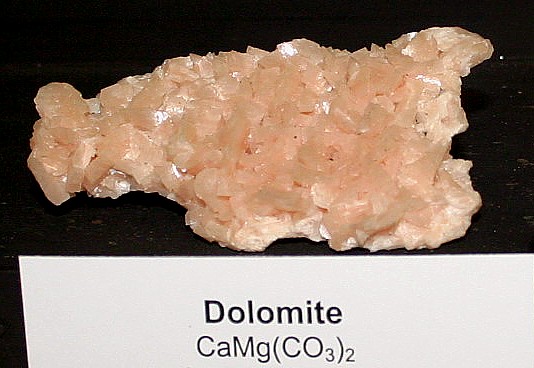Magnesium is the seventh
most abundant element in the Earth's surface crust. It is found in large
deposits of
magnesite,
dolomite, and other minerals, and in the brines of mineral
and ocean waters, where the magnesium ion is soluble. Magnesium occurs in a
large number of rock forming minerals where it is widely disbursed in many
geologic formations found in strata across the world. Both these minerals
and the soluble salts that are recovered through evaporation processes are
used industrially and as magnesium ore.
Metallic magnesium has come into use for many new purposes in recent years.
It is light and suitable for structural uses, so behind iron and aluminum,
it is the third most common structural metal, though it is the most
expensive of the three. The electrolytic metallurgical processes
involved in magnesium production are similar to those of aluminum, and the
metal is not terribly expensive, leading to many new high tech uses in light
but strong objects like cell phones and laptop computers. Originally the
metal was obtained by the reduction of magnesia with potassium or carbon at
high temperatures; but a far more economical process is to make the metal by
electrolyzing fused magnesium chloride in a mixture with alkali chlorides in
a manner similar to that used to produce aluminum.
Magnesium is a very light
metal (1.75) and alloys readily with aluminum and many other metals. These
two properties are important in many of its uses. Magnalium is an alloy of
aluminum and magnesium and used for auto wheels known as “mags”. When fairly
pure, magnesium compares with aluminum as regards conductivity, and its
lightness compared with aluminum, the specific gravity of which is 2.7,
makes this metal of considerable prospective interest in connection with the
possibility of using it for many fuel saving, lightweight components,
including the structure of aircraft and high mileage automobiles. Magnesium
combines eagerly with oxygen and nitrogen and on that account is useful for
dressing off various deleterious oxides in the manufacture of brass and
other alloys. As an illuminant, magnesium burns with a brilliant white
light, and is used for military and other purposes in making flare lights,
shrapnel trailers, fireworks, etc. Once lit afire, it is very difficult to
extinguish a magnesium flame as it does not need oxygen - it reacts strongly
with water, carbon dioxide and nitrogen. This tendency to burn
uncontrollably is the down side of its advantages as a light weight, fuel
saving metal for structural and other components. This tendency to burn
uncontrollably is the cost and down side of its advantages as a light
weight, fuel saving metal for structural and other components.
Although magnesium is an essential element in over 60 minerals, only dolomite, magnesite, brucite, carnallite, talc, and olivine are concentrated enough to be of commercial importance. Magnesite develops from the weathering of olivine and serpentine, in part after the manner indicated in the formation of laterites. It occurs in veins and fractured zones, filling cavities and replacing the serpentine wall rock. Commonly associated minerals are chalcedony and quartz. The change is probably effected through the agency of carbonated water, as indicated by laboratory testing, serpentine yielding magnesite and silica. Magnesite is also formed in some contact metamorphic reactions between dolomite and igneous intrusive rocks. Magnesium chloride salts obtained from the evaporation and subsequent refinement of ocean and other brines are also an important source for the production of this high tech metal.
Considerable deposits of magnesium ore minerals are found in California, especially in the Coast Range. For years Nevada produced considerable amounts of magnesite and brucite from a mine at Gabbs in Mineral County. The deposits of the United States once supplied a large part of the worlds needs, but in recent decades China has taken over the majority of world output. Other countries that have also produced exports of magnesite include Austria and Greece. Almost if not quite invariably the magnesite is associated with serpentine. Magnesite and magnesium compounds are used principally for making refractory brick, for smelting, for packing steam pipes, and in the manufacture of paper, carbon dioxide, oxychloride cement, medicines, dust suppression, etc.
Compact and impure talc is called soapstone. In many places talc is formed by the alteration of tremolite-bearing limestone or from the alteration of basic igneous rocks. Talc is also found in schist or other dynamically metamorphosed rocks. Dynamic metamorphism is not necessary for its development, however, as it is found also in rocks that are not highly schistose. Talc and soapstone are used as refractory materials, in laboratory tables, gas burners, electric insulators, etc. Ground to powder these minerals are used in making paper, paint, toilet powder, and dynamite.
Return
to Metal Ores Page:
Precious and Base Metal Ores

Dolomite is a Magnesium mineral that can be a source of the metal.

Magnesite is a common ore of magnesium and is mined in a number of
locations.
